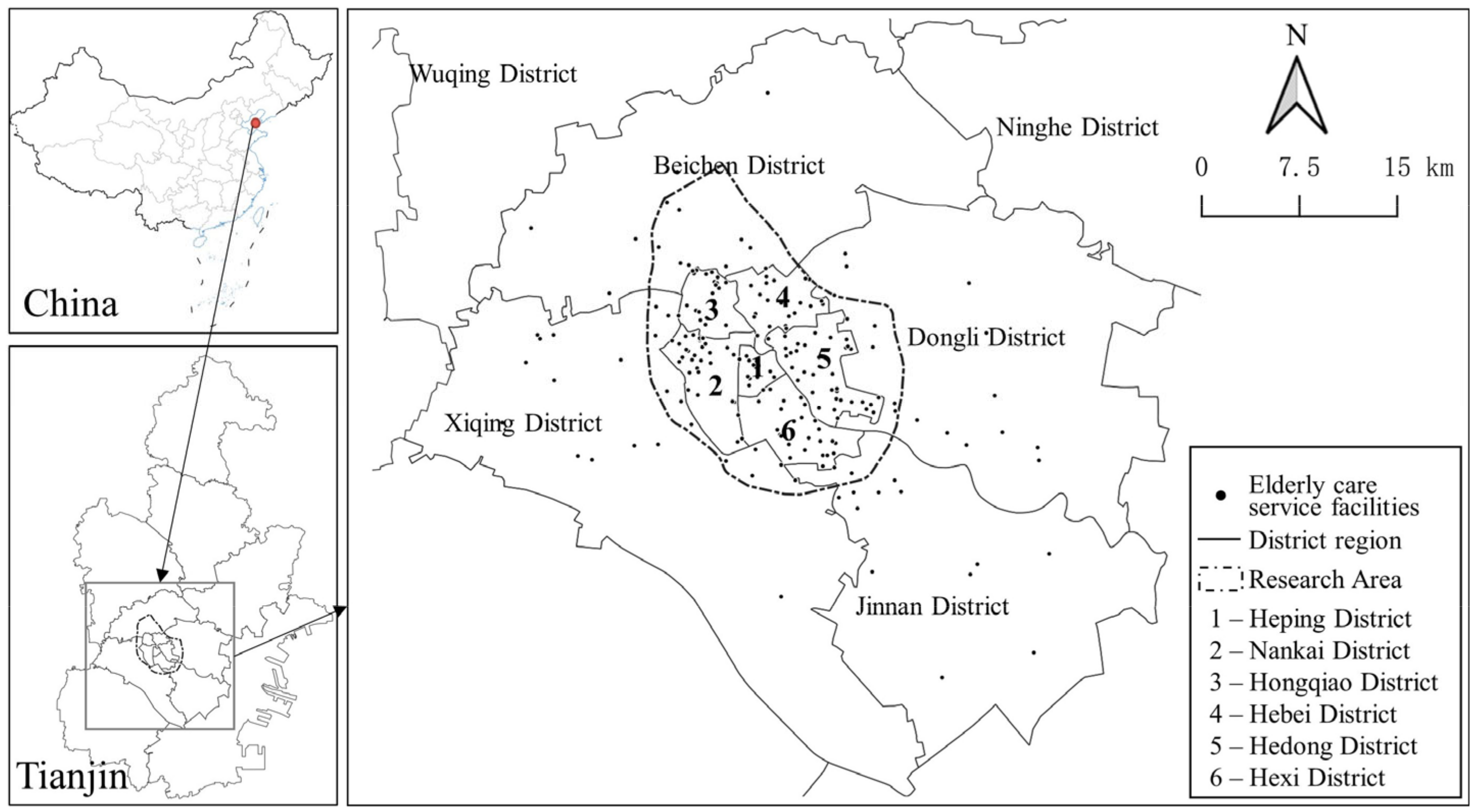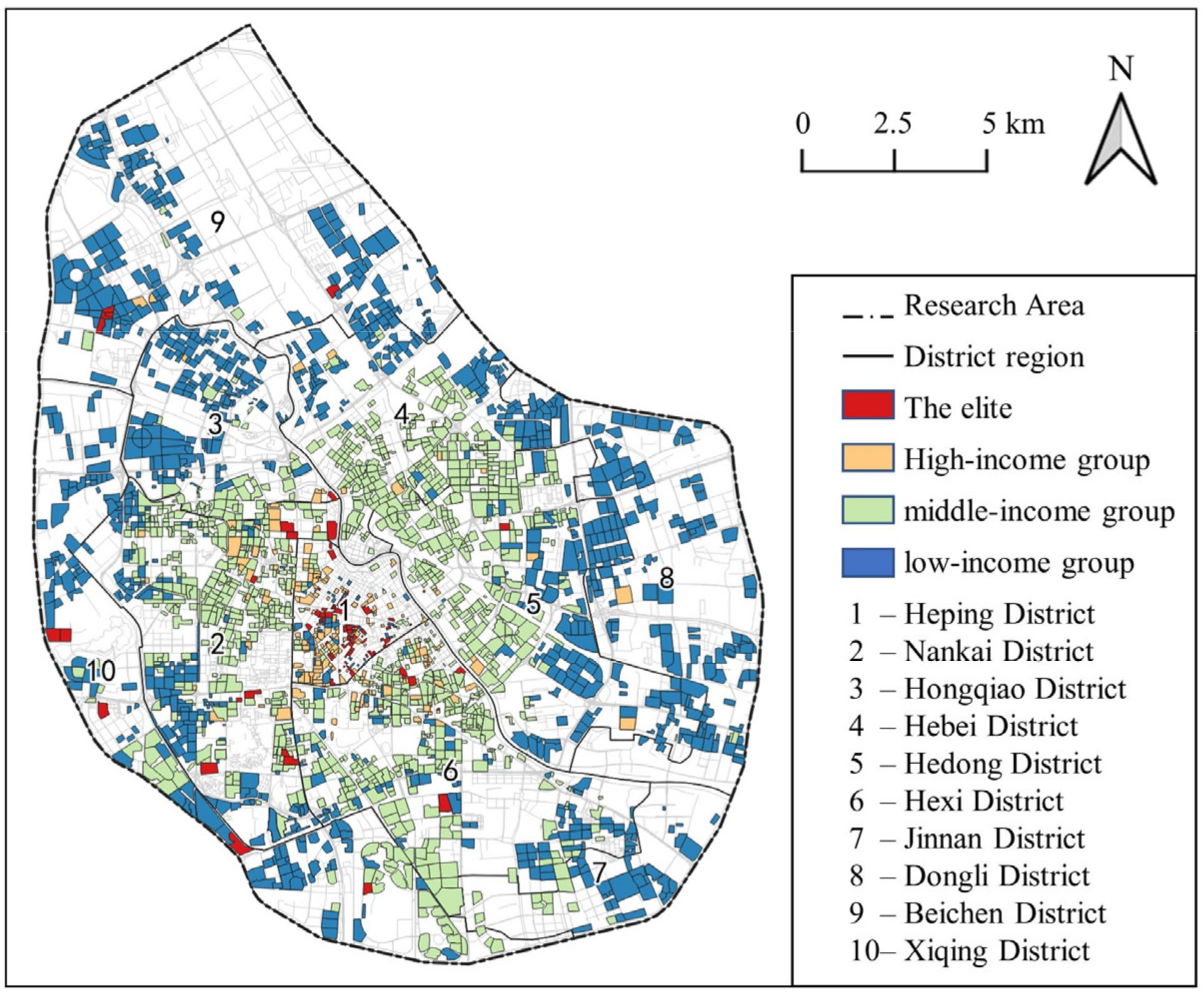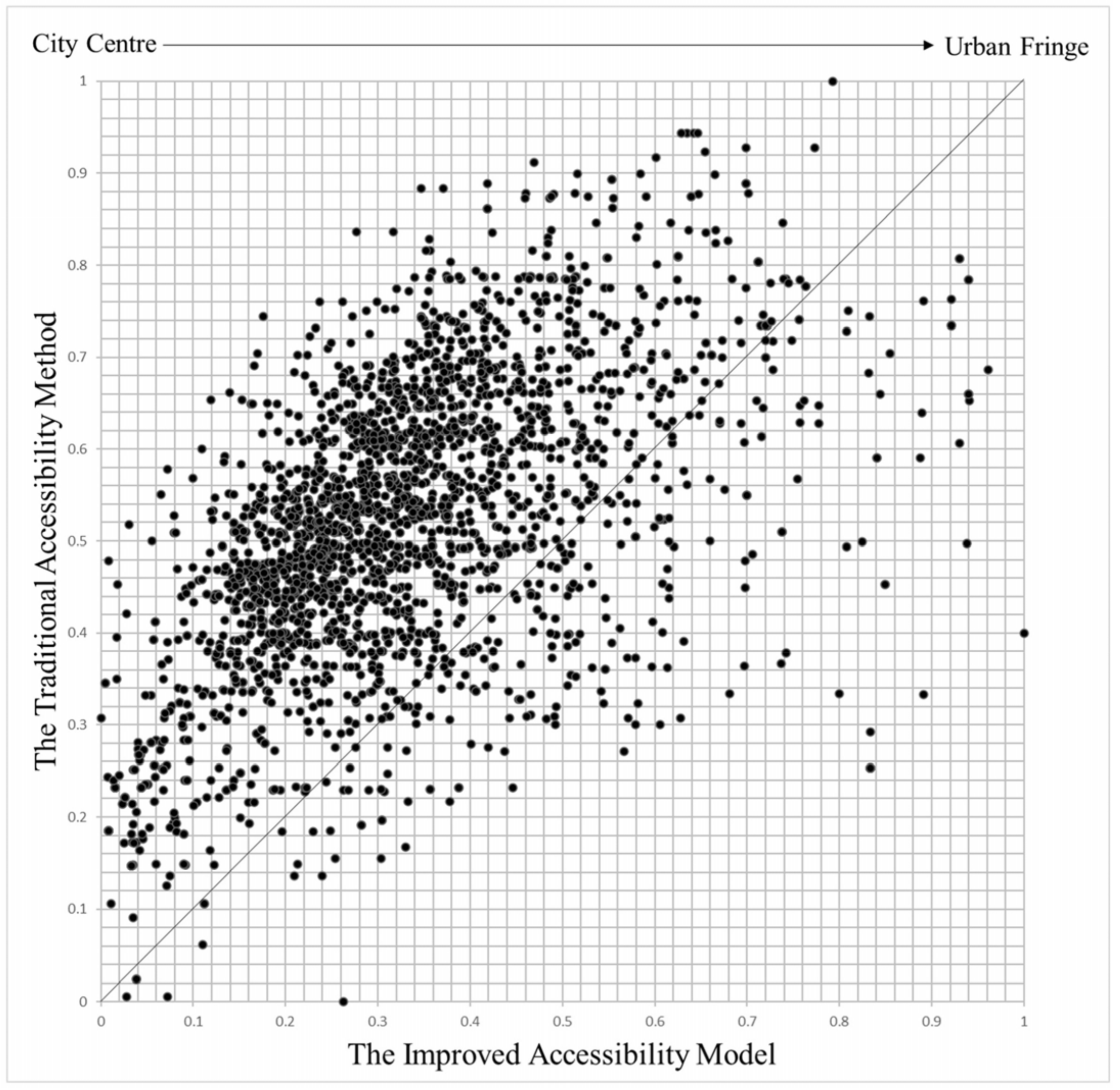Accessibility of Elderly Care Facilities Based on Social Stratification: A Case Study in Tianjin, China
Abstract
1. Introduction
2. Research Area and Data Acquisition
2.1. Research Area
2.2. Research Data
3. Method
3.1. Traditional 2SFCA Methods
3.2. Social Groups Division
3.3. Improved 2SFCA Methods
- (1)
- An identification of the demands of the elderly from different social groups for different types of elderly care facilities is performed. First, the elderly care facilities are divided into three categories according to the nature of the facility and monthly nursing expenses incurred: public elderly care facilities (government-run, less than 2000 RMB/month), including a total of 196 public elderly care facilities that offer fewer medical staff and less basic equipment; commercial elderly care facilities (private, 2000–5000 RMB/month), including a total of 136 commercial elderly care facilities in which the equipment and services are considered comfortable; and advanced commercial elderly care facilities (private, more than 5000 RMB/month), including a total of 32 advanced commercial elderly care facilities with advanced and optimal equipment that provide a better living quality. Then, 50 questionnaires were distributed to each of the four types of social groups to investigate trends in the choice of elderly care facilities. The questionnaire showed the probability of elderly residents from different social groups choosing various types of elderly care facilities, as shown in Table 1.
- (2)
- Multiple indicators are used to comprehensively calculate the supply capacity of elderly care facilities. The study incorporates the number of beds, gross floor area, total land-use area, nursing expenses, medical treatment support, and hospital support into the calculation of the supply capacity of elderly care facilities, referring not only to related research [10,11,29] but also to the standard ‘Classification and Accreditation for senior care organization’ of Tianjin city and the ‘14th Five-Year Plan of Tianjin Civil Affairs Development.’ After all the indicators are standardized, the weights of the indicators are calculated via the analytic hierarchy process; the results suggest that the indicators pass the consistency test, as listed in Table 2.
- (3)
- The API of AutoNavi Map is used to obtain travel costs. The APIs offered by the navigation service providers have been used in accessibility calculations in recent years due to their advantages in the simulation of complex urban road conditions [30,31]. This research uses the AutoNavi API path-planning interface to obtain the shortest travel time from each residential community to each elderly care facility as the travel cost.
4. Results and Discussion
4.1. Spatial Characteristics of Social Groups
4.2. Accessibility of Elderly Care Facilities in Tianjin
4.3. Comparison of Models
4.4. Discussion
5. Conclusions
Author Contributions
Funding
Institutional Review Board Statement
Informed Consent Statement
Data Availability Statement
Acknowledgments
Conflicts of Interest
References
- Wang, F.; He, P.; Yuan, C.; Wang, S. Isolated or integrated? Evaluation of ageing-friendly communities in Old Beijing City based on accessibility, social inclusion and equity. Indoor Built Environ. 2020, 29, 465–479. [Google Scholar] [CrossRef]
- Chen, W.; Cheng, L.; Chen, X.; Chen, J.; Cao, M. Measuring accessibility to health care services for older bus passengers: A finer spatial resolution. J. Transp. Geogr. 2021, 93, 103068.1–103068.14. [Google Scholar] [CrossRef]
- Talen, E.; Anserine, L. Assessing spatial equity: An evaluation of measures of accessibility to public playgrounds. Environ. Plan. A 1998, 30, 595–613. [Google Scholar] [CrossRef]
- Xia, N.; Cheng, L.; Chen, S.; Wei, X.; Zong, W.; Li, M. Accessibility based on Gravity-Radiation model and Google Maps API: A case study in Australia. J. Transp. Geogr. 2018, 72, 178–190. [Google Scholar] [CrossRef]
- Basri, H.; Jatmika, B.; Arifin, Z.; Sundari, S.; Barkah, B. Measurement of accessibility index using gravity model based on gis in sukabumi district. In Proceedings of the 2018 International Conference on Computing, Engineering and Design (ICCED), Bangkok, Thailand, 6–8 September 2018; pp. 239–243. [Google Scholar]
- Kanuganti, S.; Sarkar, A.K.; Singh, A.P. Quantifying accessibility to health care using Two-step Floating Catchment Area Method (2SFCA): A case study in Rajasthan. Transp. Res. Procedia 2016, 17, 391–399. [Google Scholar] [CrossRef]
- Yang, D.H.; Goerge, R.; Mullner, R. Comparing GIS-based methods of measuring spatial accessibility to health services. J. Med. Syst. 2006, 30, 23–32. [Google Scholar] [CrossRef]
- Di, X.; Wang, L.; Dai, X.; Yang, L. Assessing the accessibility of home-based healthcare services for the elderly: A case from Shaanxi province, China. Int. J. Environ. Res. Public Health 2020, 17, 7168. [Google Scholar] [CrossRef]
- Tseng, M.H.; Wu, H.C. Accessibility assessment of community care resources using maximum-equity optimization of supply capacity allocation. Int. J. Environ. Res. Public Health 2021, 18, 1153. [Google Scholar] [CrossRef]
- Li, H.P.; Liang, Z.H. Research on spatial equilibrium of urban community elderly care facilities and its configuration. J. Geo Inf. Sci. 2021, 23, 467–478. [Google Scholar]
- Han, F.; Luo, R. Matching of supply and demand for community service-oriented home care facilities based on accessibility measurement: A case study of Nanjing. Econ. Geogr. 2020, 40, 91–101. [Google Scholar]
- McLeod, J.D. Social Stratification and Inequality; Handbook of the Sociology of Mental Health; Springer: Dordrecht, The Netherlands, 2013; pp. 229–253. [Google Scholar]
- Dadashpoor, H.; Rostami, F.; Alizadeh, B. Is inequality in the distribution of urban facilities inequitable? Exploring a method for identifying spatial inequity in an Iranian city. Cities 2016, 52, 159–172. [Google Scholar] [CrossRef]
- Li, Y.; Lin, Y.; Geertman, S.; Hooimeijer, P.; Xu, W. Accessibility-based equity of public facilities: A case study in Xiamen, China. Appl. Spat. Anal. Policy 2021, 14, 947–968. [Google Scholar] [CrossRef]
- Tahmasbi, B.; Mansourianfar, M.H.; Haghshenas, H.; Kim, I. Multimodal accessibility-based equity assessment of urban public facilities distribution. Sustain. Cities Soc. 2019, 49, 101633.1–101633.11. [Google Scholar] [CrossRef]
- Yin, W.H.; Liu, S. Research on the spatial distribution characteristics and accessibility of Shanghai elderly care institutions. Mod. Urban Res. 2021, 6, 17–23. [Google Scholar]
- Zhang, F.; Li, D.; Ahrentzen, S.; Zhang, J. Assessing spatial disparities of accessibility to community-based service resources for Chinese older adults based on travel behavior: A city-wide study of Nanjing, China. Habitat Int. 2019, 88, 101984. [Google Scholar] [CrossRef]
- He, J.; Zhou, D.; Xu, Y.S.; Dai, J. The study on spatial accessibility measurement of pension facilities in urban community. Archit. J. 2018, S1, 18–22. [Google Scholar]
- Ji, F.X.; Zhang, H.K.; Shi, Z. Research on the impact of environmental quality of elderly care institutions on their occupancy rate—Taking Beijing as an example. Chin. J. Health Policy 2021, 14, 72–78. [Google Scholar]
- Huang, X.; Gong, P.; White, M. Study on spatial distribution equilibrium of elderly care facilities in downtown Shanghai. Int. J. Environ. Res. Public Health 2022, 19, 7929. [Google Scholar] [CrossRef]
- Martin, B.S.; Paul, J. Evaluating the performance of GIS methodologies for quantifying spatial accessibility to healthcare in Multi-Island Micro States (MIMS). Health Policy Plan. 2022, 37, 690–705. [Google Scholar] [CrossRef]
- Tianjin Municipal Bureau of Statistics. Bulletin of the Main Data of the Seventh National Population Census in Tianjin in 2020 (No. 1); Tianjin Municipal Bureau of Statistics: Tianjin, China, 2021.
- Guo, S.; Song, C.; Pei, T.; Liu, Y.; Ma, T.; Du, Y.; Chen, J.; Fan, Z.; Tang, X.; Peng, Y.; et al. Accessibility to urban parks for elderly residents: Perspectives from mobile phone data. Landsc. Urban Plan. 2019, 191, 103642. [Google Scholar] [CrossRef]
- Wang, Y.; Liu, Y.; Xing, L.; Zhang, Z. An improved accessibility-based model to evaluate educational equity: A case study in the city of Wuhan. ISPRS Int. J. Geo Inf. 2021, 10, 458. [Google Scholar] [CrossRef]
- Luo, J.; Chen, G.; Li, C.; Xia, B.; Sun, X.; Chen, S. Use of an E2SFCA method to measure and analyse spatial accessibility to medical services for elderly people in Wuhan, China. Int. J. Environ. Res. Public Health 2018, 15, 1503. [Google Scholar] [CrossRef] [PubMed]
- Chen, X.; Jia, P. A comparative analysis of accessibility measures by the two-step floating catchment area (2SFCA) method. Int. J. Geogr. Inf. Sci. 2019, 33, 1739–1758. [Google Scholar] [CrossRef]
- Wang, Y.; Fang, C.L.; Sheng, C.Y. Spatial differentiation and model evolution of housing prices in Yangzhou. Acta Geogr. Sin. 2013, 68, 1082–1096. [Google Scholar]
- Chen, L.; Zhang, Z.B.; Chang, F. The rationality of spatial configuration of public service facilities in Lanzhou. J. Arid. Land Resour. Environ. 2019, 33, 120–127. [Google Scholar]
- Cheng, T.; Liu, C.; Yang, H.; Wang, N.; Liu, Y. From service capacity to spatial equity: Exploring a multi-stage decision-making approach for optimizing elderly-care facility distribution in the city centre of Tianjin, China. Sustain. Cities Soc. 2022, 85, 104076. [Google Scholar] [CrossRef]
- Chang, Z.; Chen, J.; Li, W.; Li, X. Public transportation and the spatial inequality of urban park accessibility: New evidence from Hong Kong. Transp. Res. Part D Transp. Environ. 2019, 76, 111–122. [Google Scholar] [CrossRef]
- Ni, J.; Liang, M.; Lin, Y.; Wu, Y.; Wang, C. Multi-mode two-step floating catchment area (2SFCA) method to measure the potential spatial accessibility of healthcare services. ISPRS Int. J. Geo Inf. 2019, 8, 236. [Google Scholar] [CrossRef]





| Social Groups | Advanced (%) | Commercial (%) | Public (%) |
|---|---|---|---|
| The elite | 50 | 30 | 20 |
| high-income group | 30 | 40 | 30 |
| middle-income group | 20 | 40 | 40 |
| low-income group | 10 | 30 | 60 |
| Indices | Weighting Coefficient | Calculation | |
|---|---|---|---|
| Facility capacity | The number of beds | 0.5574 | The standardized number of beds in the facility |
| Gross floor area | 0.10837 | The standardized value | |
| Facility conditions | Total land-use area | 0.08362 | The standardized value |
| Nursing expenses | 0.15902 | The standardized monthly nursing expenses | |
| medical service | Medical treatment support | 0.05866 | The standardized number of service types |
| Hospital support | 0.03292 | The standardized number of hospitals within 1 km | |
| Social Groups | Amount (Proportion) | Average Price per Square Metre/RMB | Property Fee/RMB/Year | Building Age/Year | Greening Rate/% | Plot Ratio | Schools within 3 km | Hospitals within 3 km | Shops within 3 km | Parks within 3 km |
|---|---|---|---|---|---|---|---|---|---|---|
| The elite | 58 (3.18%) | 61,494 | 2.16 | 23.8 | 28.48 | 2.08 | 174.8 | 53.7 | 1189.8 | 38.5 |
| high-income group | 153 (8.39%) | 49,133 | 1.76 | 24.9 | 24.26 | 2.12 | 193.0 | 60.6 | 1278.8 | 41.5 |
| middle-income group | 835 (45.8%) | 28,903 | 0.97 | 24.4 | 25.3 | 1.86 | 158.4 | 43.8 | 1011.1 | 25.6 |
| low-income group | 777 (42.62%) | 21,856 | 0.99 | 25.0 | 26.44 | 1.75 | 100.0 | 21.5 | 587.39 | 13.8 |
Disclaimer/Publisher’s Note: The statements, opinions and data contained in all publications are solely those of the individual author(s) and contributor(s) and not of MDPI and/or the editor(s). MDPI and/or the editor(s) disclaim responsibility for any injury to people or property resulting from any ideas, methods, instructions or products referred to in the content. |
© 2023 by the authors. Licensee MDPI, Basel, Switzerland. This article is an open access article distributed under the terms and conditions of the Creative Commons Attribution (CC BY) license (https://creativecommons.org/licenses/by/4.0/).
Share and Cite
Liu, B.; Qiu, N.; Zhang, T. Accessibility of Elderly Care Facilities Based on Social Stratification: A Case Study in Tianjin, China. Sustainability 2023, 15, 1507. https://doi.org/10.3390/su15021507
Liu B, Qiu N, Zhang T. Accessibility of Elderly Care Facilities Based on Social Stratification: A Case Study in Tianjin, China. Sustainability. 2023; 15(2):1507. https://doi.org/10.3390/su15021507
Chicago/Turabian StyleLiu, Bangyu, Ning Qiu, and Tianjie Zhang. 2023. "Accessibility of Elderly Care Facilities Based on Social Stratification: A Case Study in Tianjin, China" Sustainability 15, no. 2: 1507. https://doi.org/10.3390/su15021507
APA StyleLiu, B., Qiu, N., & Zhang, T. (2023). Accessibility of Elderly Care Facilities Based on Social Stratification: A Case Study in Tianjin, China. Sustainability, 15(2), 1507. https://doi.org/10.3390/su15021507






